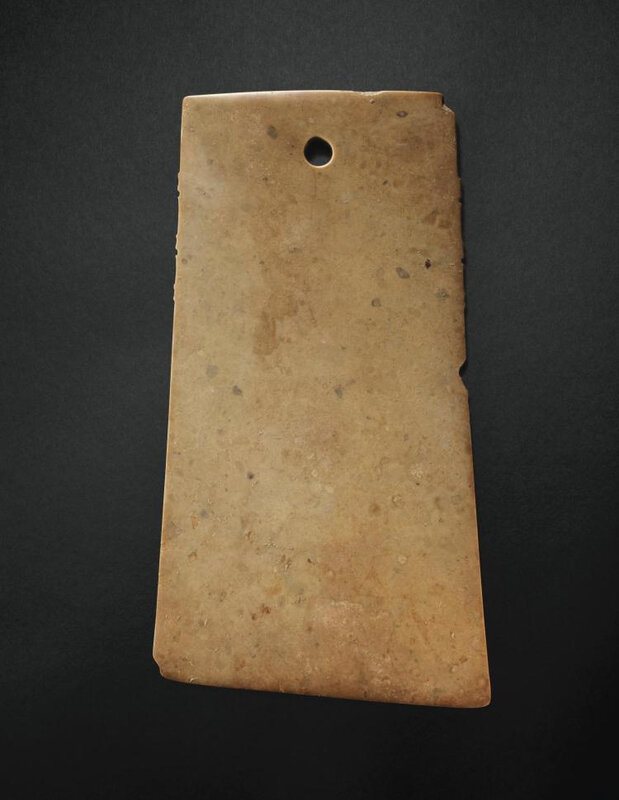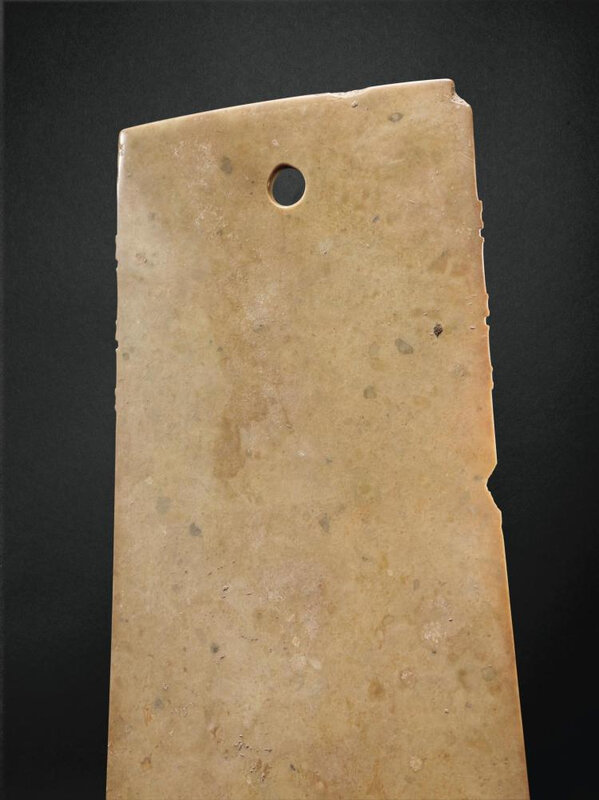Rare Grande Hache Cérémonielle en jade, époque Néolithique, culture Longshan, ca. 2000-1500 avant J.-C.
Lot 35. Rare Grande Hache Cérémonielle en jade, époque Néolithique, culture Longshan, ca. 2000-1500 avant J.-C.; 34,5 x 18,5 cm. Estimation 50,000 — 70,000 EUR. Lot Vendu 75,000 EUR. Courtesy Sotheby's 2015.
de forme rectangulaire, les côtés évasés dans la partie basse, les côtés tranchants arrondis dans le haut et dans le bas en partie arrondis et en partie pointus et très fins, le sommet légèrement arqué au rebord arrondi, chacun des deux rebords latéraux légèrement concaves, la partie supérieure flanquée d'une série de trois très légers crans de chaque côté, percée en son centre à proximité du bord supérieur, la pierre opaque au doux poli d'une belle teinte chaude couleur chamois avec des taches et des lignes plus foncées, une face couverte d'incrustations, D.W 3289.
Exhibited: Arts de La Chine Ancienne, Musée de l’Orangerie, Paris, 1937, no. 73.
Literature: Georges Salles, Arts de La Chine Ancienne, Paris, 1937, cat. no. 73 (not illustrated).
Note: Large and imposing jade blades, thinly cut and carved of opaque greenish-brown stones with smoothly polished surfaces such as the present piece from the David-Weill Collection, are generally associated with the neolithic Dawenkou and Longshan cultures of eastern China, compare examples illustrated in Kaogu xuebao 1964. 2, pls. 5:2 and 11:1. However, small projections and notches carved on either side of this fine blade are considered to be a feature that appears only on jade blades of the Longshan culture, see Jessica Rawson, Chinese Jade from the Neolithic to the Qing, London, 1995, pp. 167-176, cat. nos. 10:12 and 10:13.
The present blade was acquired in 1932. The Longshan site at Chengziyai, Shandong, was first excavated by Wu Jinding in 1928 and 1930-31. Over 2000 sites in Shandong are linked to the Longshan culture and it is quite likely that the present blade was discovered at the time of the first excavations.
A number of similar blades though of smaller size, are known, see, for example, four blades from the Sonnenschein Collection, illustrated in Alfred Salmony, Archaic Chinese Jades from the Edward and Louise B. Sonnenschein Collection, Chicago, 1952, XXIV:1-4; compare another large jade blade published by Howard Hansford, Chinese Carved Jades, London, 1968, pl. 17a, and H. F. W. Visser, Asiatic Art in Private Collections of Holland and Belgium, Amsterdam, 1948, pl. 54, nos. 90 and 91. A second, even larger jade blade from the David-Weill Collection, probably also of Longshan origin, is illustrated in Georges Salles, Arts de la Chine Ancienne, Paris, 1937, cat. no. 71.
Sotheby's. Trésors de la Chine ancienne de la collection David David-Weill, Paris, 16 Dec 2015

/https%3A%2F%2Fprofilepics.canalblog.com%2Fprofilepics%2F1%2F0%2F100183.jpg)
/https%3A%2F%2Fstorage.canalblog.com%2F03%2F02%2F119589%2F96711876_o.jpg)
/https%3A%2F%2Fstorage.canalblog.com%2F11%2F31%2F119589%2F94773502_o.jpg)
/https%3A%2F%2Fstorage.canalblog.com%2F20%2F83%2F119589%2F94772815_o.jpg)
/https%3A%2F%2Fstorage.canalblog.com%2F26%2F72%2F119589%2F75604929_o.jpg)
/https%3A%2F%2Fstorage.canalblog.com%2F59%2F60%2F119589%2F26458628_o.jpg)






/image%2F1371349%2F20240509%2Fob_ed2ac9_441053101-1665688864201126-25411828058.jpg)
/image%2F1371349%2F20240509%2Fob_8e71e8_438162296-1666330364136976-74099222377.jpg)
/image%2F1371349%2F20240509%2Fob_17669d_442467910-1666327360803943-61167260172.jpg)
/image%2F1371349%2F20240509%2Fob_6f4afe_441307920-1666326470804032-43768106294.jpg)